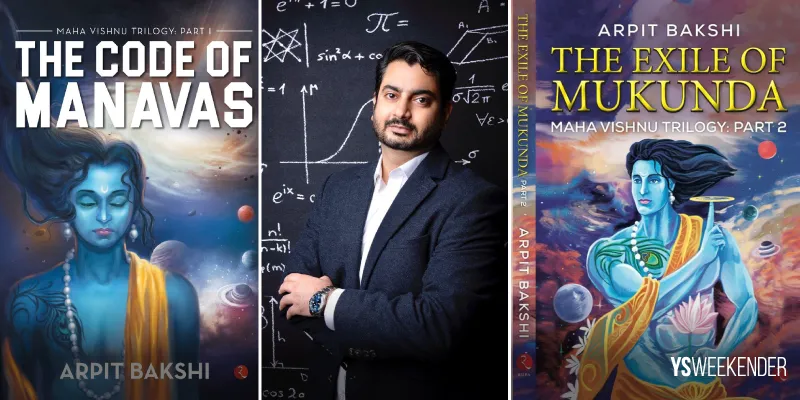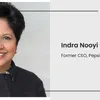How this writer is standing out in the crowded Indian mythological sci-fi space
Gurugram-based writer Arpit Bakshi has just released the second book in his Maha Vishnu Trilogy series, which focuses on Indian mythological characters fighting for dominance of the cosmos. In a tete-a-tete with Weekender, he reveals more details about his writing process and inspirations.
When a story incorporates characters from Indian mythology in a fast-paced thrilling setting, it is bound to catch the attention of many.
Aware of this, author Arpit Bakshi chose to set his books – the Maha Vishnu Trilogy – in the time of Lord Vishnu. High on the success of the first book in the series called The Code of Manavas, Arpit quickly churned out the second book, The Exile of Mukunda, which is now available in all major bookstores across India and on ecommerce platforms like Amazon.
“The Exile of Mukunda, which is the second part of the Maha Vishnu Trilogy, brings a mind-boggling twist to the Manavas’ apocalyptic adventure. I have portrayed a subtle blend of science fiction and fantasy, inspired by Indian mythology.
“The Exile of Mukunda exhibits different emotions of love, hate, unions, separations, trust, and treachery. The story mainly revolves around Mukunda, who is the son of Krishna, the protagonist of the first book in the series. I hope that the detailed plot of this novel will keep readers hooked till the end and take them on a journey of thrill and adventure,” Arpit says.
On the occasion of the release of his second book, Arpit joins YS Weekender for a candid chat.
Excerpts from an edited interview:
YS Weekender (YSW): Congratulations on your new book! Why did you choose to become a writer?
Arpit Bakshi (AB): Thank you! I was born in Meerut, and pursued engineering from JSS-ATE in Noida. After graduating, I joined Infosys and lived in Mysore and Pune before moving to New York to pursue an MBA in finance from the Lally School of Rensselaer Polytechnic Institute (RPI). Studying in their beautiful library, I developed a strong love for science and technical books, especially ones that focused on the study of the cosmos and the secrets of the universe.
When I returned to India, I knew I wanted to write about science but I also wanted to make it interesting, which is what led to writing science fiction.
I had always been an avid reader and would dwell on the genesis of the universe and similar subjects. Soon, I was imagining the existence of a human race smarter than the one currently occupying the Earth. I was keen to explore how they would conduct themselves in different situations of conflicts and crises, and before I knew it, I had characters and a plot for a novel.
The book was originally planned as one volume, but the story was too vast to be contained in one book. I have never been formally trained but I read a lot, and I read everything –fiction, non-fiction, or articles. This has helped me a lot.

Author Arpit Bakshi feels that Indian mythology is a huge source of unlimited wisdom – so the choice to write fanstasy sci-fi fiction rooted in India was a 'natural one'.
YSW: Why did you choose mythological fiction as your subject?
AB: I wanted my science fiction series to be as Indian as it possibly could. Further, I firmly believe that the Indian ethos stems from Indian mythology, and was clear that the foundation of the book series would be based on Indian mythology. Honestly, I also feel that our vast Indian mythology is a huge source of unlimited wisdom – so the choice was a natural one!
YSW: How was your first book received? Why do you feel your work strikes a chord with so many people?
AB: The amount of love and appreciation I received for the first book was unbelievable, and quite overwhelming! I self-published the first book and within two months it was picked as the Editor’s Choice on e-book app Kobo. Four months after publication, I started receiving emails and messages from readers about how much they loved my work and were looking forward to the next book in the series. It was all surreal, and then came the big news.
The phenomenal reception of the book led to it being picked by Rupa Publications. I believe that my honest and unique style of writing helps my readers connect with me.
YSW: What does your writing process entail?
AB: It takes me almost two-three years to complete each book. The writing takes about a year and the rest goes into research and character development. I usually start by picking a theme, and design a rough plot, characters, the three act structure and all the scientific concepts that I want to concentrate on. Then I mull over the idea and let it grow in my mind.
Once that is done I begin writing one chapter at a time. So the process is more intuitive than planned.
Once you have the character traits in mind, the story usually follows its own natural flow. I feel I just have to devote time and the story writes itself.
YSW: Tell us about your latest work. What can your readers expect that is distinctive from the first one?
AB: The Exile of Mukunda offers more characters, and focuses on more kingdoms fighting each other for dominance. There are also scientific concepts which complement the struggles and aspirations of each character.
YSW: If not mythological fiction, what genre do you think you would write?
AB: I feel I would always stick to science fiction, though I may experiment with sub-genres like humans occupying multiple planets. Honestly, this seems a very plausible theme in the not-too-distant future. With many private players entering the space race, who knows how soon we may become a multi-planetary species.
YSW: Where do you get your inspiration from and how do you research your work?
AB: I read a lot and watch loads of documentaries. Also, I love to observe my surroundings, especially when I visit new places. I want to know what kind of people inhabit the place, what cuisines they have, their culture, history; even the local soil and topography interest me.
YSW: What is your favourite part of this series?
AB: I have included a brief four-page paper called The Theory of Gravity, at the end of the book. It shows gravity as a force emanating from the fabric of the cosmos. This is a novel theory of Relativistic Gravity, in which I propose that space-time is not a barren vacuum, and instead interacts with matter and exerts force on matter, which causes inertia.
My theory builds on the observations of the scientist Hubble, and states that mass-bearing objects such as the earth and the sun, slow down the expansion of space-time, which in turn causes times to slow down and objects to gain kinetic energy through acceleration.
To be precise, each point in space-time can be represented by an acceleration vector. Therefore, we don’t actually need the stress-energy tensor, as proposed by Einstein, and only need this acceleration vector, which can be calculated by observing the blueshift of a light beam passing through observed space time.
This proposition of mine is in direct conflict with Einstein’s Theory of General Relativity and is in the nascent stages of exploration as its math hasn’t yet been concluded, but I firmly stand by what I believe, and have included this theory in my book. I hope lots of people read this paper and share their thoughts with me.
Edited by Teja Lele










